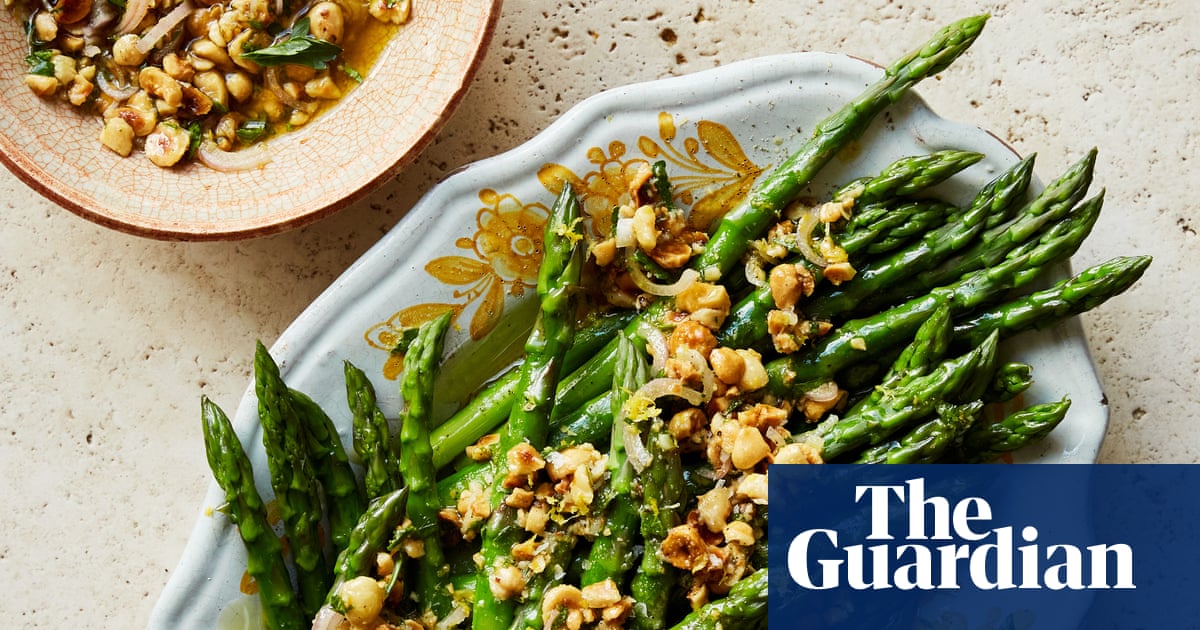Coming as I do from a family with a colourful array of dietary requirements, I can verify that these veg-forward dishes seriously perform on both the texture and flavour fronts, as well as being achievable crowdpleasers. British asparagus swoops in around now, offering bright green relief from winter’s hardier vegetables, while the jarred and frozen veg in the gratin save on prep time and keep everything light.
Put the relish together while the nuts are still warm, because that helps them absorb the flavours and create a condiment that’s both bright and deeply savoury.
Prep5 minCook30 minServes6
100g blanched hazelnuts1 round shallot, peeled and finely chopped100ml extra-virgin olive oil2 tsp sherry vinegarJuice and zest of ½lemon½ small bunch fresh parsley, leaves and tender stems finely chopped¼ tsp salt400g asparagus
Heat the oven to 200C (180C fan)/390F/gas 6. Tip the hazelnuts on to a tray and roast for 10 minutes, until deep golden. Meanwhile, mix the shallot, oil, vinegar, lemon juice and zest, parsley and salt in a small bowl.
While the roast nuts are still hot, pound them in batches in a mortar until they look rubbly (you’re aiming for some larger, chunky pieces and plenty of small ones, but no whole nuts). Tip the still-warm nuts into the oil and vinegar mix, then taste and adjust the seasoning.
Trim the thicker, tough ends off the asparagus spears and use a vegetable peeler to peel the bottom half of each spear (save the peelings for stocks or soups). Steam the asparagus for four minutes, until bright green and tender to the point of a sharp knife, then lift out and arrange on a warm platter.
Drizzle a third of the nut relish over the asparagus, and put the rest in a bowl on the table so everyone can top themselves up. Serve immediately. Any leftover relish can be kept covered in the fridge for up to five days; it’s wonderful spooned over polenta and greens, or drizzled over new potatoes.
A molten, crunchy-topped gratin full of tender, verdant greens is sure to elicit a few “oohs” and “aahs” at the table.
Prep15 minCook1 hr 10 minServes6
For the cheesy mustard sauce40g unsalted butter40g plainflour500ml whole milk100g extra-mature cheddar, grated1 heaped tbsp wholegrain mustard100ml dry sherry, or white wineSea salt andblack pepperFor the gratin4 tbsp extra-virgin olive oil2 leeks, cleaned, then white and green parts sliced into 1cm rounds2 large garlic cloves, peeled and finely chopped100g spinach100g frozen broad beans50g frozen peas250g jarred artichoke hearts(drained weight), cut into quarters600g jar cannellini beans, drained1 small bunch fresh mint, leaves picked and chopped75g soft white breadcrumbs30g almonds, roughly chopped
First make the sauce. Melt the butter in a medium saucepan on a medium-low heat. Once it’s bubbling, stir in the flour and cook, stirring, for a couple of minutes. Gradually whisk in the milk, then cook, stirring regularly, for five to seven minutes, until the mixture thickens and coats the back of the spoon. Stir in the cheese, mustard and sherry, and season to taste.
Heat the oven to 200C (180C fan)/390F/gas 6. Put half the oil in a large, shallow casserole or 30cm ovenproof frying pan on a medium-high heat, then add the leeks and a half-teaspoon of salt, and cook, stirring often, for five to seven minutes, until softened and just starting to colour in places. Stir in the garlic and saute for a minute, until fragrant.
Add the spinach, broad beans and peas, cover the pot and leave to cook for two minutes, until the spinach wilts. Add the artichokes, cannellini beans, cheesy sauce and mint, stir to combine, then take off the heat.
In a small bowl, stir the breadcrumbs and almonds with the remaining oil. Scatter this all over the top of the cheesy vegetable mix, then cover and slide on to the middle shelf of the hot oven and bake for 25 minutes. Lift off the lid, then bake for 15 minutes more, until the top is browned and the gratin is bubbling. Remove and leave to cool for five minutes before serving.
Anna Shepherd is a food writer and author of Love Vegetables (White Lion Publishing, £20). To order a copy for £18, visitguardianbookshop.com
